If there’s one dish I love, it’s orzo salad. Orzo is one of those incredibly versatile foods that can be combined with so many others. It actually reminds me a lot of risotto in that orzo is lightly browned before it’s cooked. And after it’s browned, it’s prepared just like risotto is. If you’ve never tried orzo before, you’re in the right place. I’m going to cover a lot of ground in this post and once all that ground is covered, I’ll give you a recipe that’ll knock your socks off. It’ll be easy to prepare and it’ll taste great – I promise.
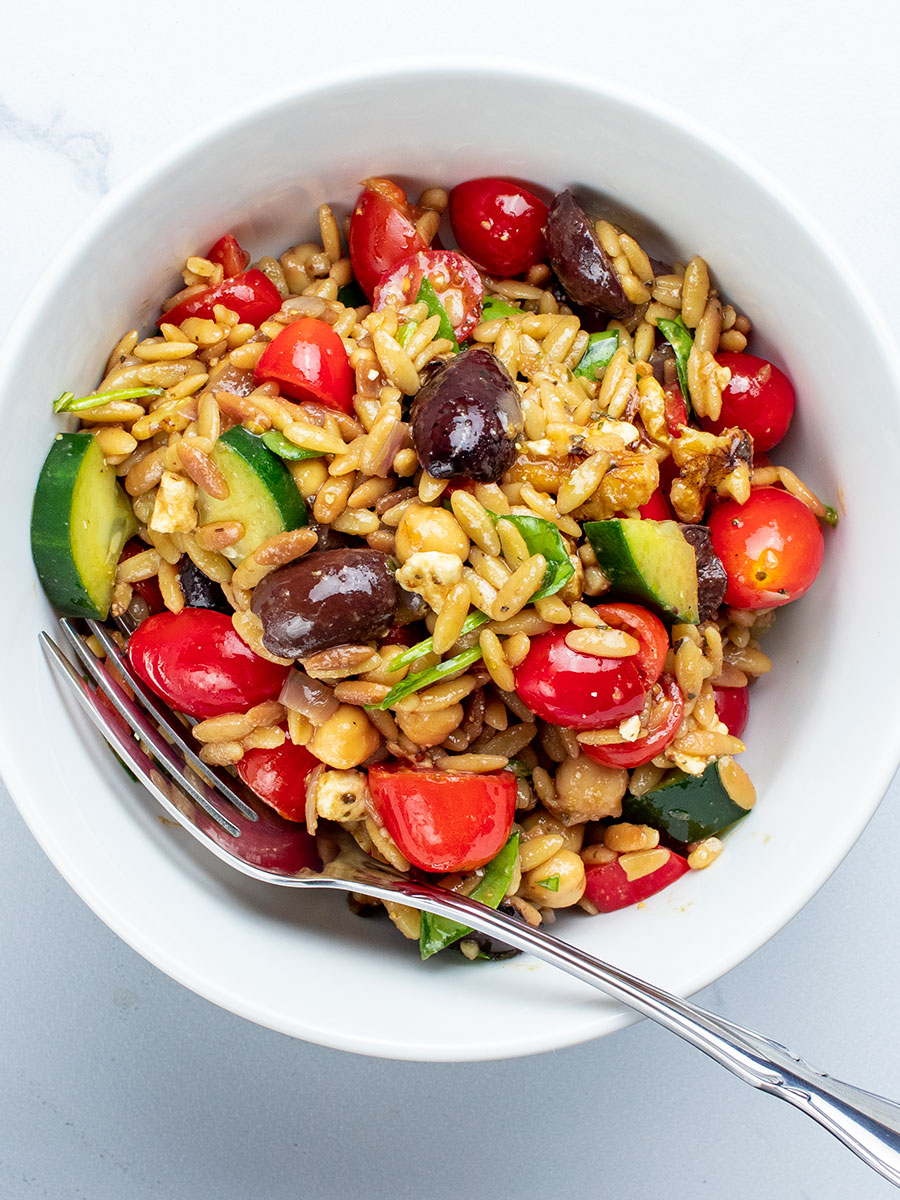
The Perfect Mediterranean Version
What does Mediterranean mean as it pertains to food? What exactly is the Mediterranean diet? Where did the Mediterranean diet originate?
The Mediterranean diet originated exactly where you might guess – near the Mediterranean; in those southern countries that border the sea – Spain, Italy, and Greece. More specifically though, the diet was formed in southern Spain, southern Italy, and Crete. It’s a diet that’s based on whole foods such as olive oil, dairy, meat, fruits and vegetables, fish, condiments, spices, and wine. You’ll know it when you taste it. Think beans, nuts, seeds, tasty green and black olives – those sorts of things. There are no processed foods in this diet. It’s all about health and flavor.
Why has the Mediterranean diet become so popular? Because it’s healthy and it offers many benefits to the body. These benefits primarily include having positive effects on the cardiovascular system. Personally, I love it because the food is incredibly interesting to look at and enjoyable to work with. I’ve always enjoyed fruits and nuts and I prefer olive oil over butter. I like lentils and whole wheat bread, and olives and artichokes are simply the best. Add some red wine to all that and you’ve got a winner.
As you scroll down to the ingredients list for this recipe, you’ll notice that it seems sort of…well, Mediterranean. I kept it that way on purpose. When combined with orzo, the region’s flavors pop. Cherry tomatoes, onions, cucumbers, bell pepper, walnuts, Kalamata olives, chickpeas, and of course, feta cheese. Can you think of anything more Mediterranean than that?
Is Orzo Healthy?
Orzo isn’t some superfood like lentils are. It’s really just pasta in a somewhat unique shape. It looks sort of like a large grain of rice. Is it healthy? It can be if it’s the whole-wheat version. Otherwise it’ll be made of semolina flour, from which a lot of pasta is made. As part of a balanced diet, I’d say orzo is neutral – it can supply carbs and protein, but otherwise, there’s nothing overwhelmingly healthy about it.
History of Orzo
As you may have guessed, being a type of pasta, orzo originated in Italy. But just because it originated in Italy, it doesn’t mean it stayed there. Orzo quickly became popular in many countries in the region, such as Spain, Greece, those in northern Africa, as well as those in the Middle East. Basically, those that surround and are in proximity of the Mediterranean Sea.
While we in America call this food orzo, it’s also known as risoni in Italian (big rice), which is what’s used in classic Italian wedding soup. And as I described in the section above, it does actually look like a large grain of rice, or perhaps even more so like a raw grain of barley.
Orzo can be found in many recipes for side dishes, salads, and soups. It’s widely used in Spain and Greece. In Spain, it’s called piñones, the Spanish translation for pine nut. In Greece, orzo is used in a soup that contains beef, spices, and a rich tomato sauce. So, as you can see, orzo is popular, has a strong following, and is quite versatile.
Mediterranean Orzo Salad Ingredients
In this section, I’ll offer some ingredient descriptions for the “big” ingredients as well as photos of the same. For all the specifics and instructions for preparing this recipe, be sure to check the recipe card below.
Cherry Tomatoes – Cherry tomatoes, grape tomatoes, whatever you’d like to use. As long as the tomato is firm and stays together well in a salad, it’ll be fine. I recommend the sweeter variety though because that’ll add some nice flavor.
Cucumber – Cucumbers are nice in this salad because they’ll add some freshness to the overall dish. Just be sure to quarter the cucumber slices, not just halve them. You’ll want each piece to be bite size.
Red Onion – If red onion is too strong for you, you can easily use a sweet or Vidalia variety instead. I personally enjoy the strength of the red onion and it adds a nice look to the dish, but you can adjust to your own tastes.
Red Bell Pepper – Red peppers look great in this salad and add some depth of flavor. If you can’t find red, use yellow or green. It’s not a problem at all.
Kalamata Olives – This type of olive is suggested because of its beautifully rounded smoky and fruity flavors. I can just as well imagine using a flavorful black olive – the good kind in the jar, not the can. Canned olives don’t offer nearly the amount of flavor as do the jarred varieties. Whatever you choose, be sure it’s a quality olive as much of this dish relies upon it.
Walnuts – In this recipe, I don’t instruct that the walnuts are toasted. Although, that’s not to say that the entire dish wouldn’t benefit from toasted walnuts. Toasted are always better than non. If you do decide to brown them, be sure to only lightly brown them. Walnuts have a tendency to quickly burn while in the frying pan, so keep a close eye on things.
Feta Cheese – Feta cheese is a staple in this dish, so I’m not sure I’d recommend substituting anything else in its place. If you absolutely can’t find any feta, then go with a more firm and salty cheese such as parmesan, asiago, or pecorino. In a real pinch, I’d even use mozzarella, but again, feta is definitely “betta.”
Garbanzo Beans (Chickpeas) – You’ve got two varieties to choose from; dry or canned. To save time, use canned chickpeas, but if you’ve got the dry version and the time, by all means, they’ll be just as delicious in this dish. Just cook them using the instructions on the package.
Orzo – And finally, the orzo. Most grocery stores sell the common variety of orzo. I love it because it’s made with a hearty semolina flour that’s derived from a coarsely milled durum wheat. It’s got a rugged “bite” to it. For future preparations though, I think I’d use the whole wheat variety, as whole wheat is always more healthy than non and it would be in keeping with the Mediterranean diet.
Enjoy some photos below of the ingredients I just discussed.


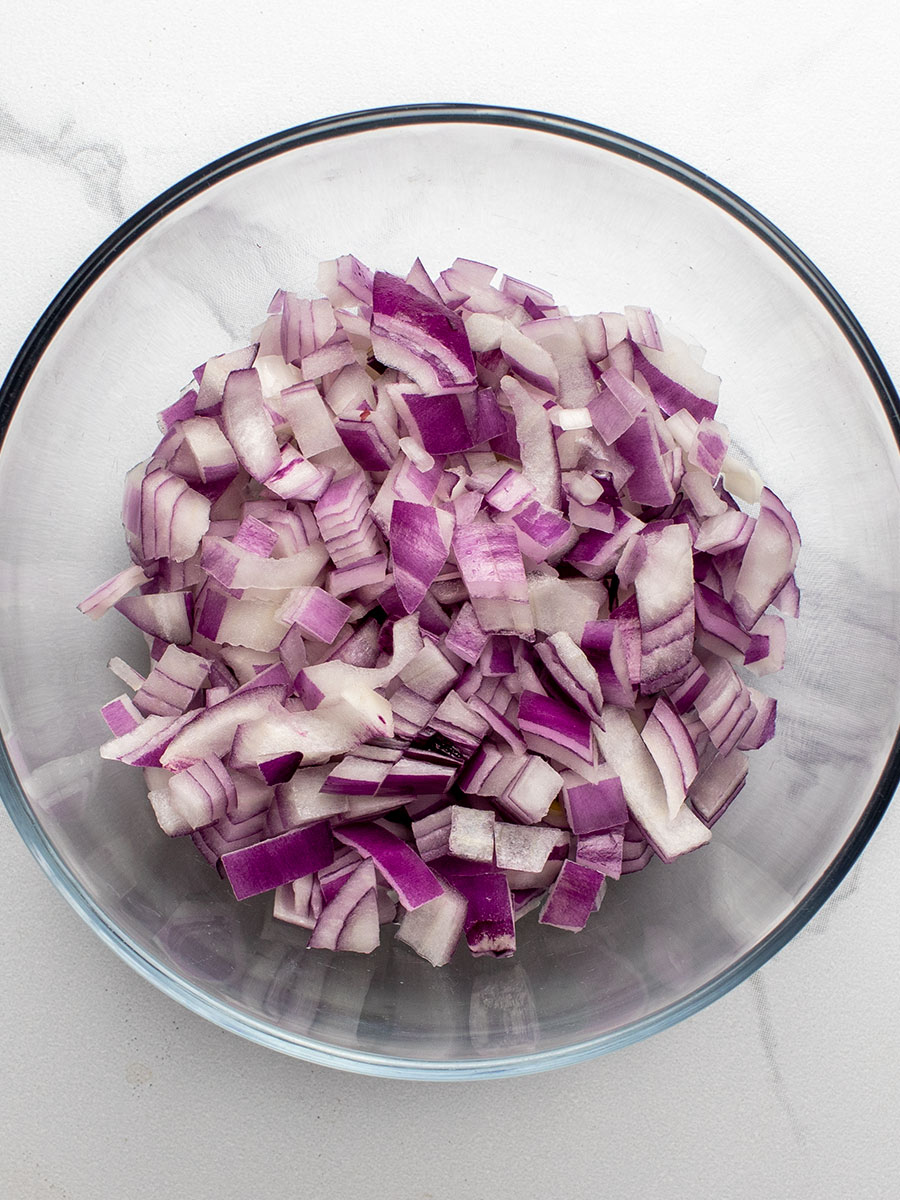
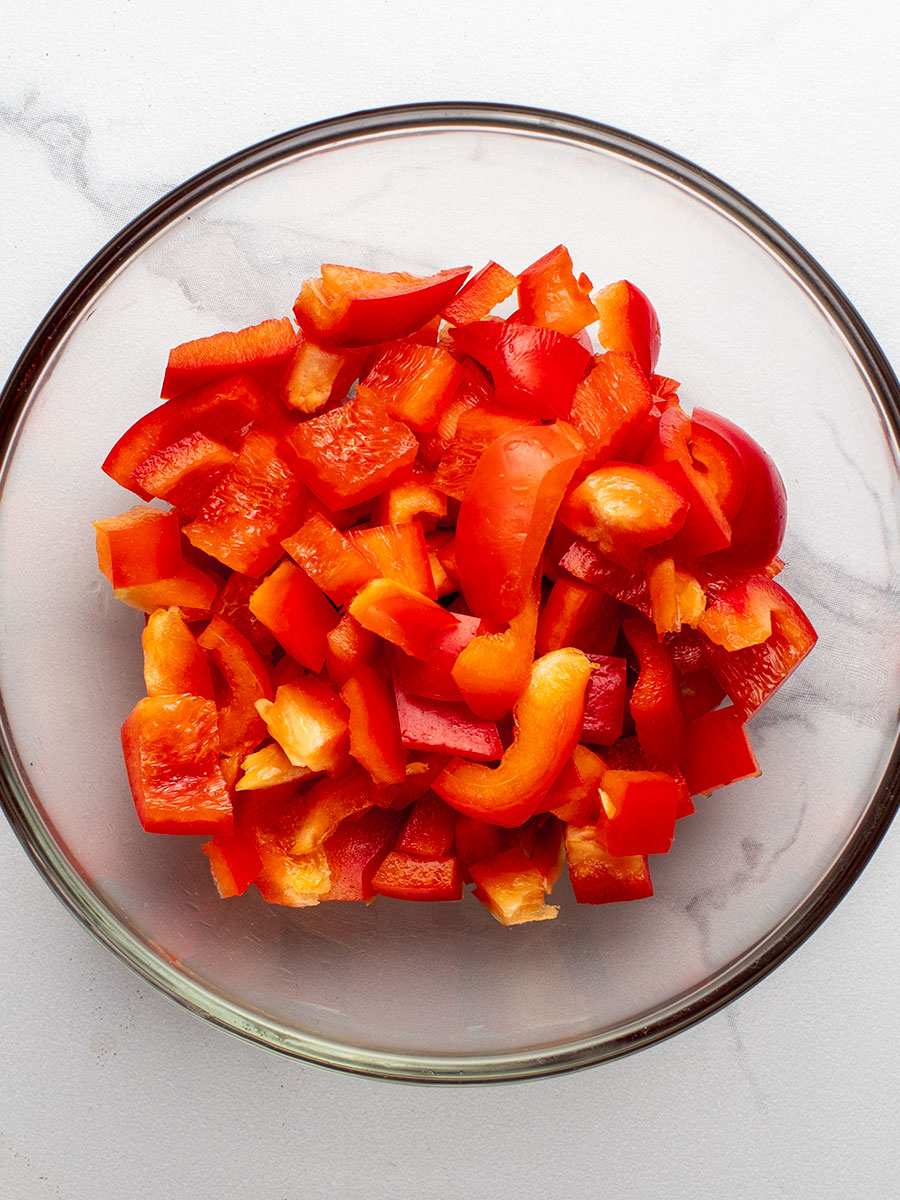
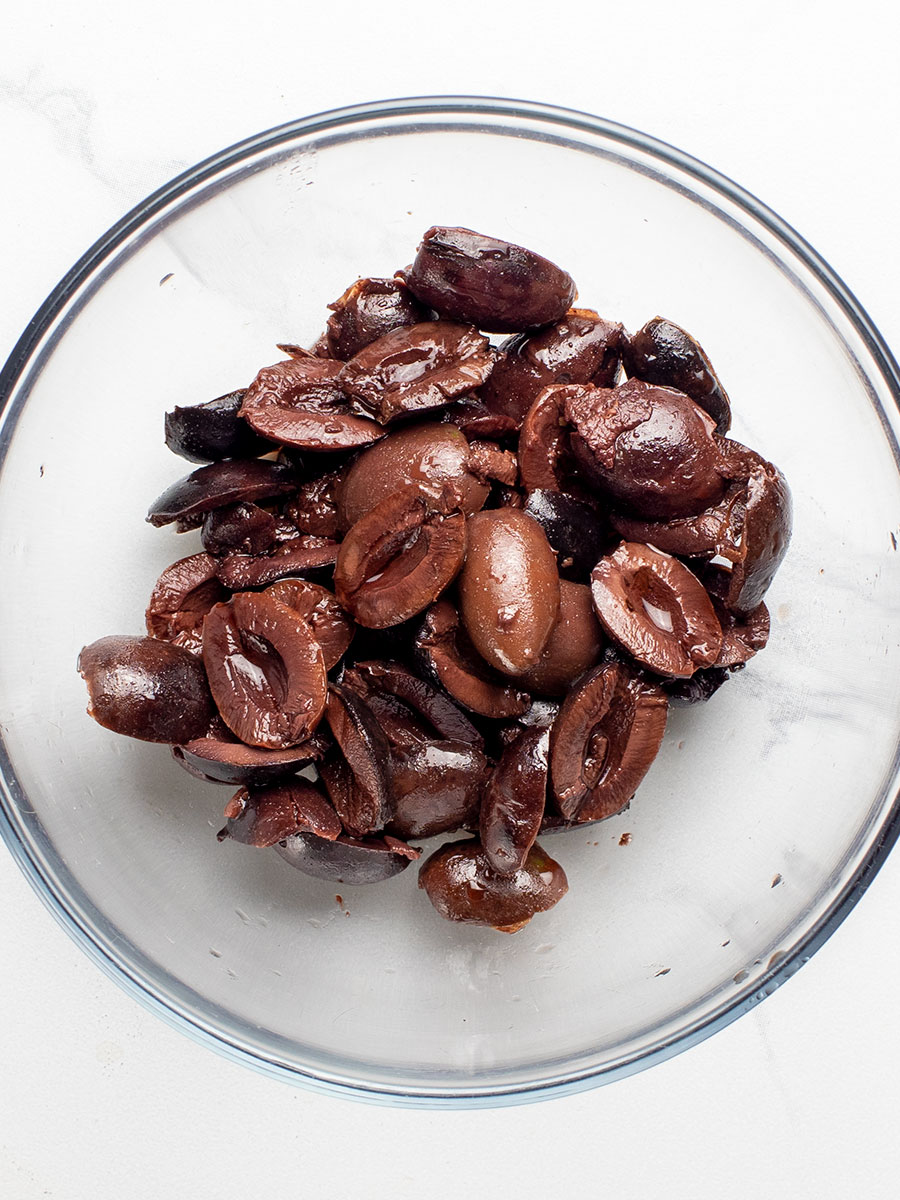
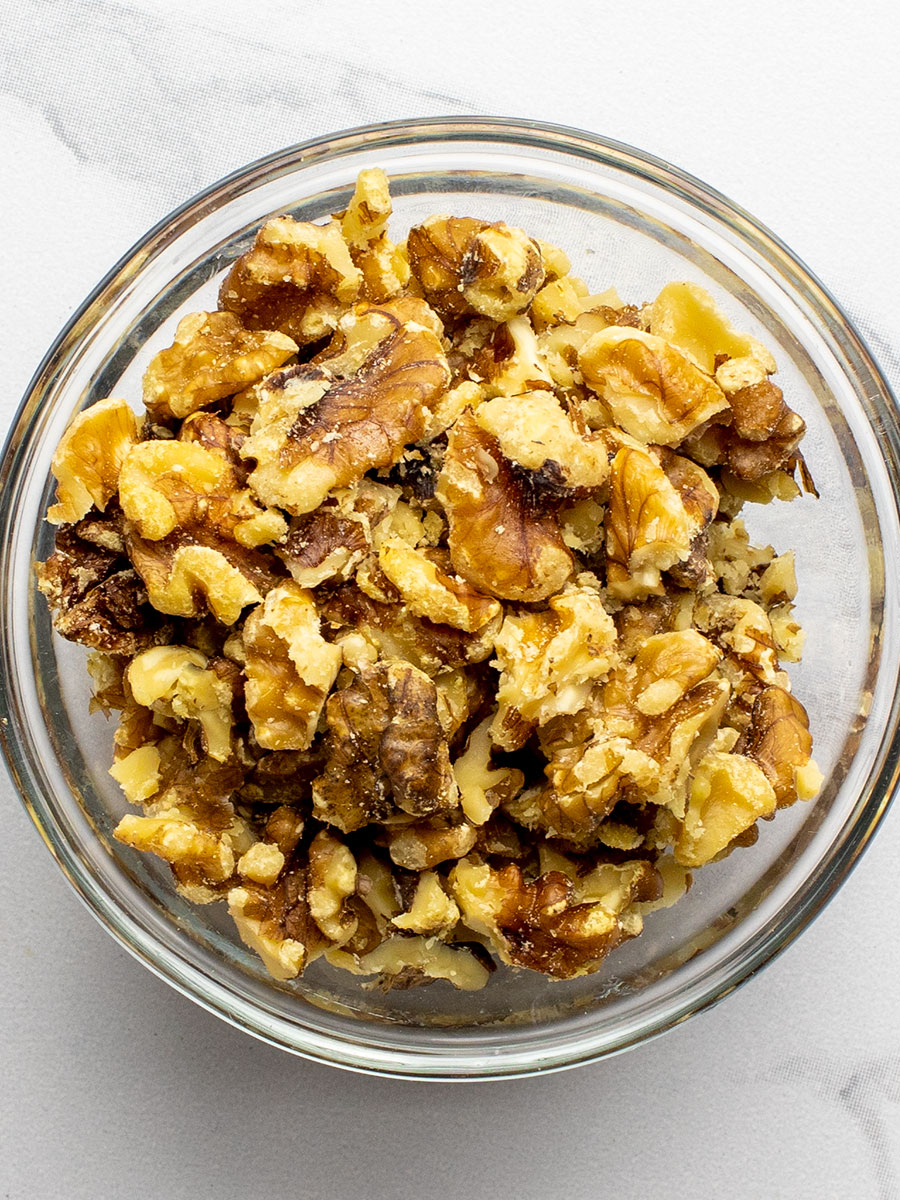

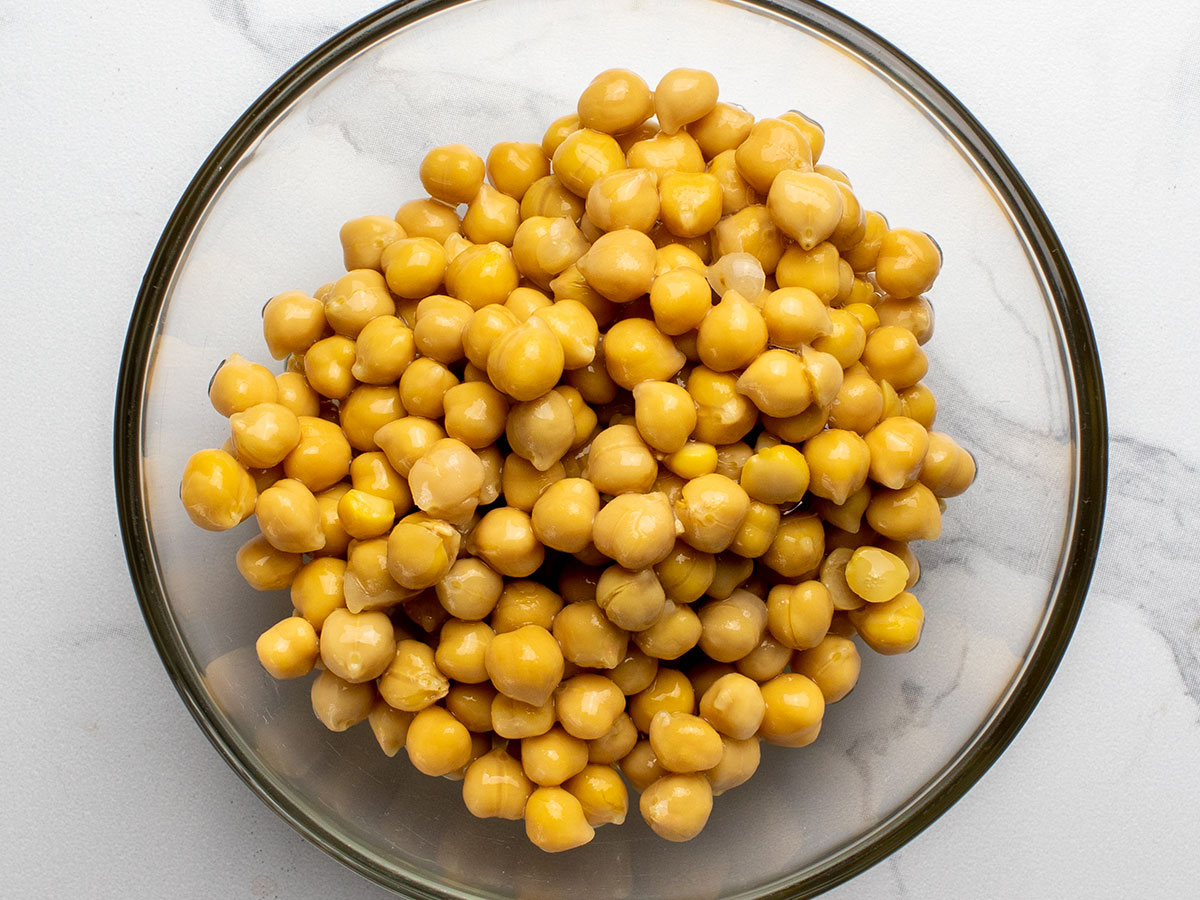
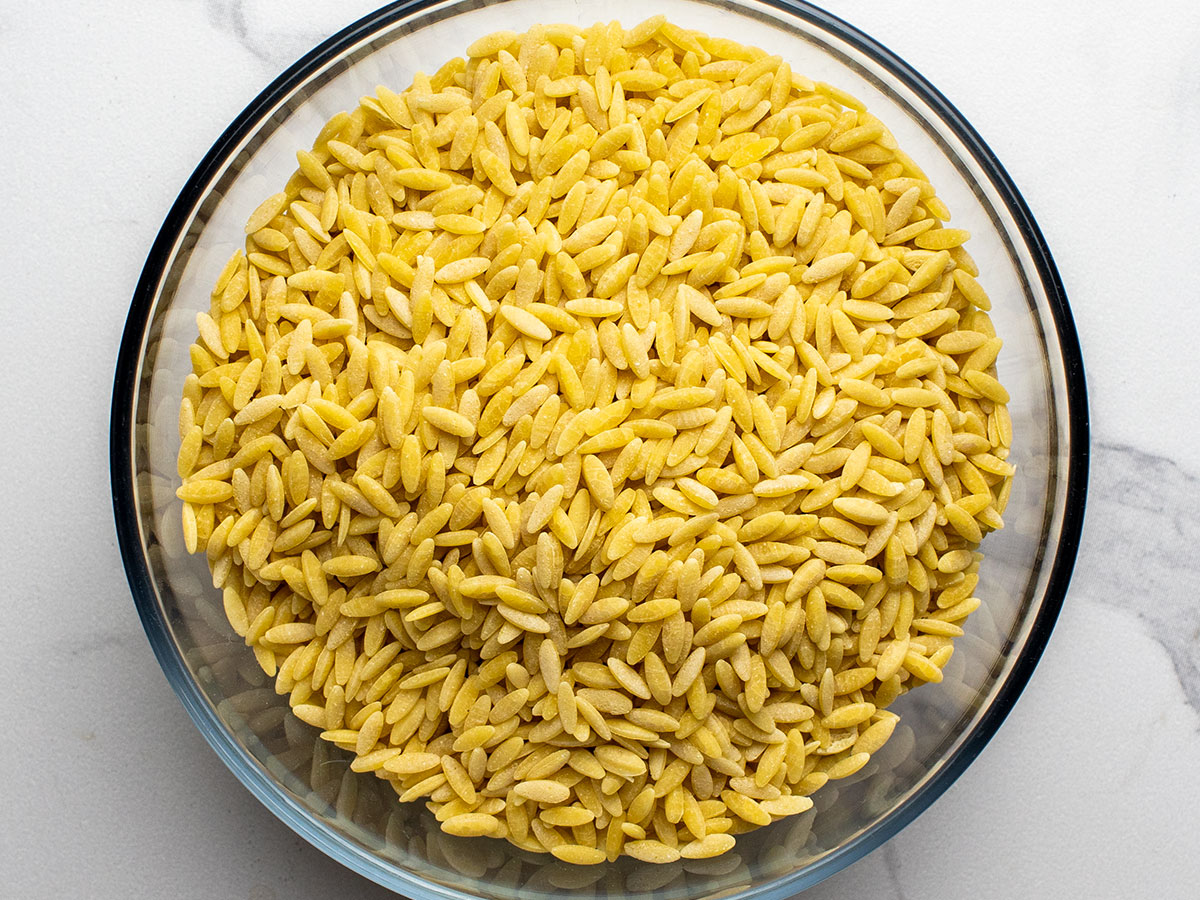
Pro Tip
Did you know that orzo is a super-versatile food? It can be used in a variety of dishes and Italians use it all year round in many of theirs. From cold salads to comfort foods, orzo can easily be the star of the show. Below, I’ll list just a few of the dishes in which orzo can be used.
- Orzo-Stuffed Peppers
- White Bean Soup with Escarole
- Lemon Mushroom Orzo
- Roasted Veggie Orzo
- Summertime Orzo & Chicken
- Grilled Vegetable Orzo Salad
- Orzo with Spinach and Pine Nuts
- Italian Wedding Soup
- Whole Wheat Orzo Salad
- Shrimp Orzo with Feta
How to Cook Perfect Orzo
If you’ve ever prepared risotto, you’ll find the process of preparing orzo oddly familiar. It’s actually very simple. The goal is to first add flavor to the dry orzo by way of browning and then to inject flavor into the center of the orzo by way of cooking with broth and seasoning. For these instructions, I’ll tell you how to cook plain orzo with no other ingredients besides the basics: butter, olive oil, broth, salt, and pepper. For this recipe specific instructions, please see below.
To start, warm a skillet on your stovetop to medium-low heat. Add one tablespoon of olive oil and one tablespoon of butter to the skillet. Then, add the dry orzo to the pan. The goal with this step is to lightly brown the orzo, so as you begin to smell the orzo toasting, stir it. Periodically stir for about five minutes until you see some color on the pasta.
Next, increase the heat on your stovetop to medium-high. To the skillet, add four cups of chicken or vegetable broth, 1/4 teaspoon of salt, and 1/4 teaspoon of ground black pepper. Keep stirring for about 8-10 minutes or until the orzo is al dente. When it is, turn off the heat and remove the orzo from the pan. That’s it! Perfectly cooked orzo. Again, for instructions specific to this recipe, please see below.
Cooking Equipment Needed for Orzo Salad
If you cook on a regular basis, you won’t need anything beyond what you most likely already have. For this dish, you’ll need some measuring spoons, measuring cups, bowls of various sizes, whisk (or a fork), cutting board, chef’s knife, skillet, can opener (if you decide to use canned garbanzo beans), and a stove. Like I said, it’s all very straightforward.
How to Prepare Mediterranean Orzo Salad
These are very general instructions for this dish. For more thorough instructions, please see the recipe card below.
This dish can be prepared in three phases. First is the preparation of the vinaigrette (dressing), second is the prep of the salad, and third is the cooking of the orzo. These steps needn’t go in order. You can complete them any which way you want.
Make the Vinaigrette
To make the vinaigrette, in a medium sized bowl, combine the olive oil, balsamic vinegar, lemon juice, dry Italian herbs, sugar, mustard, garlic powder, ground black pepper, and salt. Whisk everything together until the ingredients are thoroughly combined.
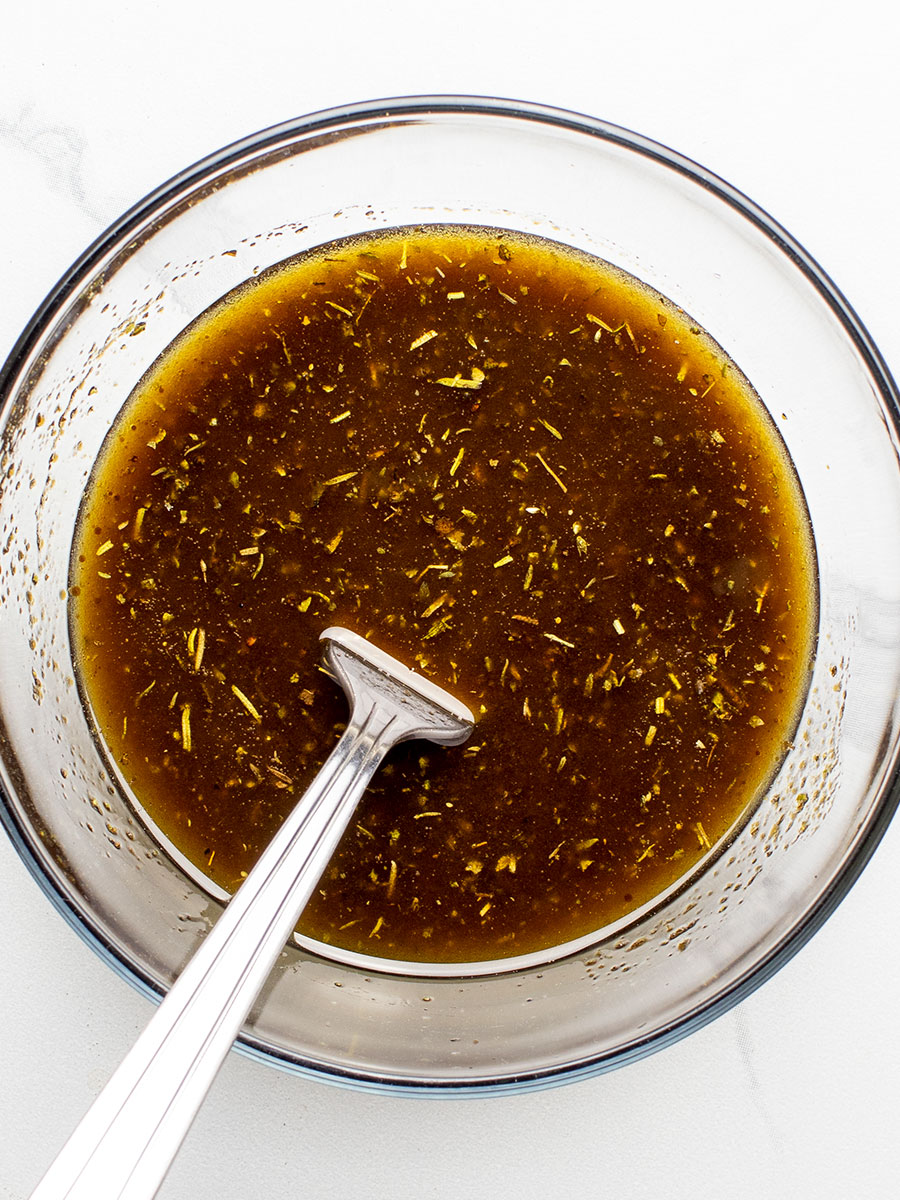
Prep & Combine the Vegetables
In a large bowl, combine the prepped cucumber, red bell pepper, tomatoes, chickpeas, olives, walnuts, basil, and feta cheese.
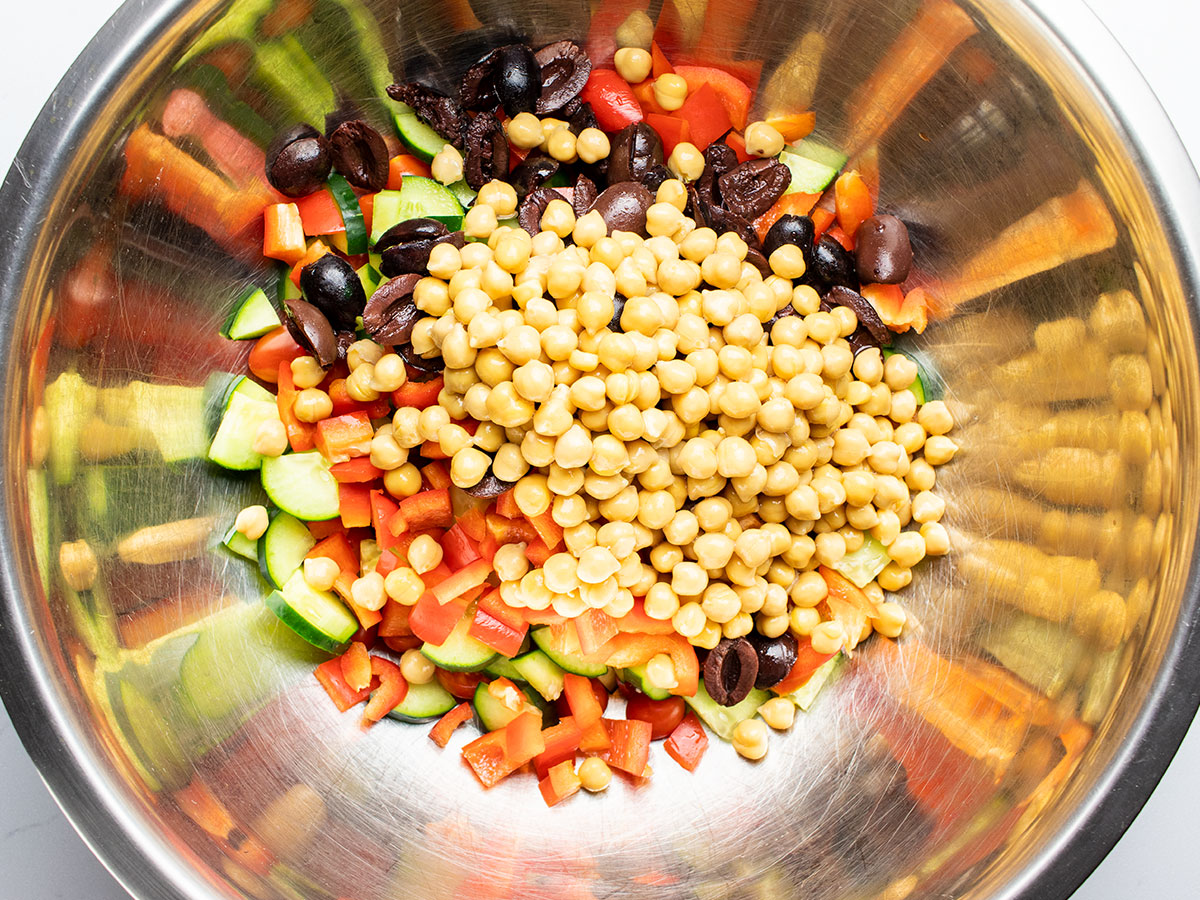
Cook the Orzo
Add the orzo, butter, olive oil, and onion to a medium-low heated skillet. Cook for five minutes. Add the broth, lemon juice, salt, and pepper to the skillet and raise the heat to medium-high. Continue cooking for about 10 more minutes until al dente. When finished, remove from pan and let cool.
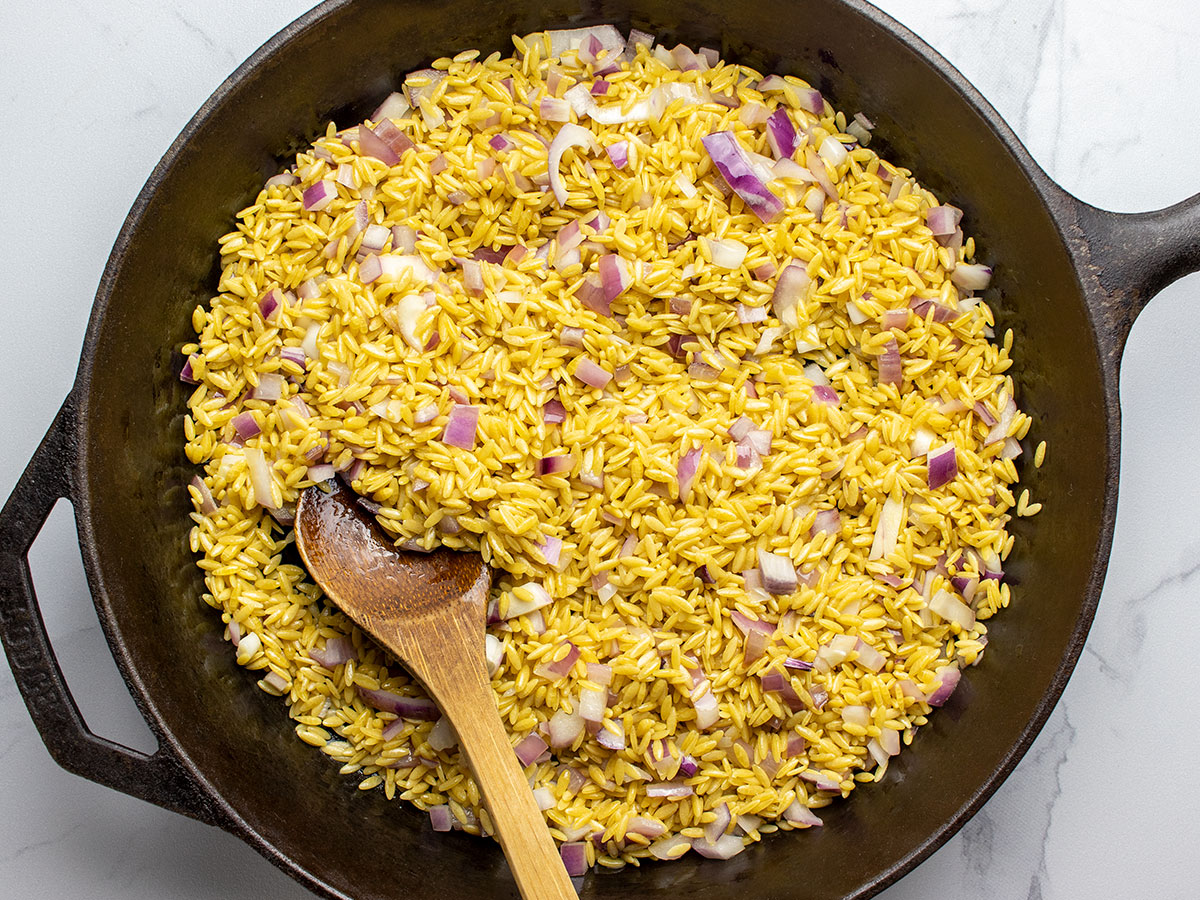
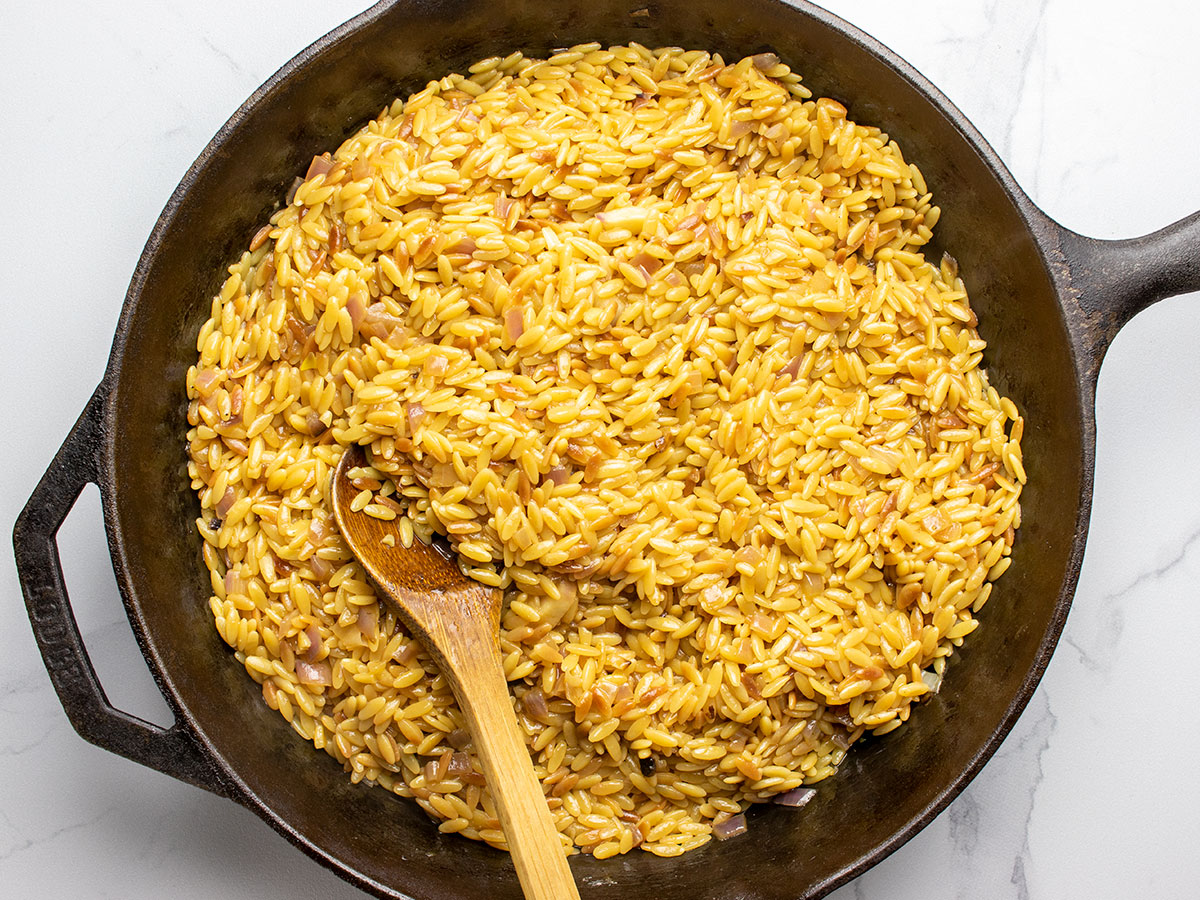
Combine All Ingredients
Once the orzo has completely cooled, add it to the large bowl that contains the veggies. Then, add in the vinaigrette and stir until everything has been coated by the dressing.
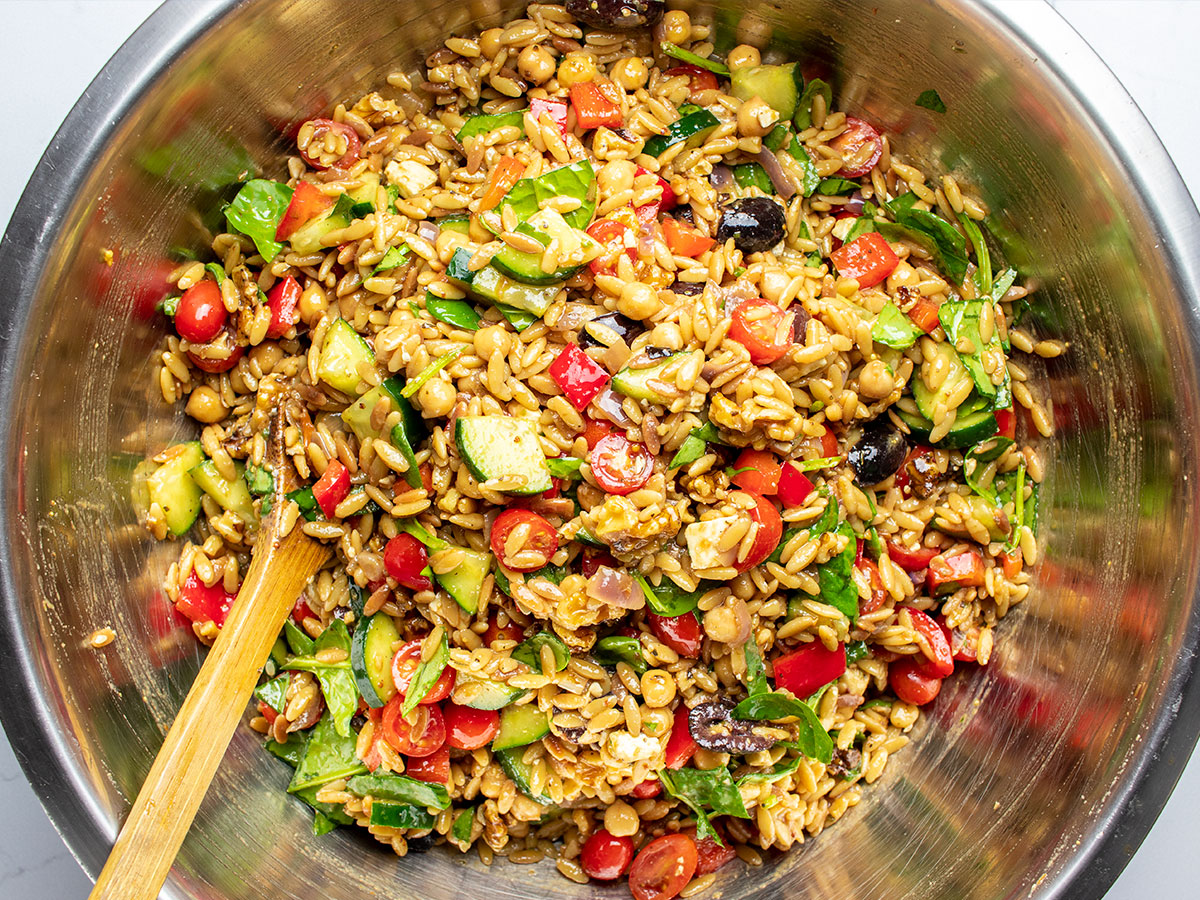
After that, plate and serve.
Substitutes & Additions
I’m not sure you’d call what I’m going to discuss in this section “substitutions.” Perhaps they’d be better referred to as “alterations.” Basically, this is a versatile salad and the ingredients can be changed around however you’d like. I’ll discuss some of the most popular changes next.
What to Substitute Kalamata Olives With
If I were going to swap out the Kalamata olive for another type of olive, I’d most likely choose the stuffed Spanish Manzanilla kind. These are of the green variety that are readily available in virtually any supermarket. They’re quite the cost-effective alternative as well. If budget wasn’t a concern, I’d definitely go with a much more fancy option, such as the intensely flavored Beldi olive from Morocco. These are somewhat difficult to find and obviously more expensive than the regular supermarket olives, but they’re so flavorful, it’d be worth the effort and expense. Another black option would be the Nyon olive from France. This is a wrinkly fruit that’s got a meaty texture and a mildly bitter flavor. The reason I bring up the olive alternatives is because you can truly alter the trajectory of this salad, taste-wise, just by changing this one ingredient. It plays that large a role.
What to Substitute Feta Cheese With
I know I touched upon feta cheese alternatives in the Ingredients section above, but let’s dive a bit deeper into this ingredient substitution.
I stand by my parmesan, asiago, and pecorino substitutions. Each of these are salty and firm. But what if we continued on to include more cheese varieties? Some that are actually closer to feta itself. I’ll list a few that might be considered: halloumi, ricotta salata, queso blanco, and goat cheese. Each of the four I listed is somewhat similar in either taste, texture, or both. Personally, I’d prefer the goat cheese, but that’s just because I’ve never had a bad experience with it. The taste is excellent, the texture is smooth, and if chilled, it crumbles like feta.
Other Alternatives
Don’t let any of the ingredients I listed in this recipe stop you from changing what you’d like to change. But if you do make some alterations, just be sure to keep the spirit of the Mediterranean alive. Try adding some capers, different types of olives, tomatoes, hotter peppers, or even change the type of vinegar in the vinaigrette. Browse the condiment aisle of your favorite food market to see what’s available. Perhaps some roasted red peppers, sun-dried tomatoes, pickles, artichoke hearts, roasted nuts, green peppercorns, and/or anchovies. These are all great substitutes and additions, each with their own unique flavor and texture.
Dishes That Complement Orzo Salad
When you think about dishes that complement orzo salad, don’t ignore those dishes that would complement pasta salads in general. Yes, this one happens to lean toward the Mediterranean arena, but it’s still a variation of a pasta salad. With this in mind, I’ll list some complementary dishes below. So if you’re considering preparing this orzo salad, think about one of these dishes as well.
- Kielbasa Sandwich
- Fresh Garden Salad
- Fresh Fruit Salad with Greek Yogurt Dip
- Roast Beef Sliders
- Honey Mustard Grilled Chicken
- Taco Pasta Salad
- Grilled Pork Chops
- Turkey Pesto Panini
- Mediterranean Chopped Salad
- Mediterranean Roasted Vegetables
- Old Fashioned Baked Beans
- Chicken Bacon Ranch Sliders
- Turkey Burgers
- Mexican Chopped Salad
Wine Pairings for Orzo Salad
Obviously, you can prepare this orzo salad any time of year, but when I think of this dish, I think of walking into a backyard BBQ with it in my hands. Me, holding a big bowl of this salad and placing it down on a picnic table. Since it’s likely a summer salad, the question is, what type of wine would pair well with it?
There are two things to keep in mind when considering a wine to pair with this dish. First, this is a mild tasting salad, therefore it would best pair with a smooth white wine. Second, this orzo is essentially pasta, and pasta is Italian in nature, perhaps an Italian wine would be appropriate. Really though, yes, this may be a Mediterranean dish, but that shouldn’t dictate which wine it’s paired with. The flavors should. With that in mind, I suggest these wines (left column contains the primary suggestions and the right column the secondary):
- Soave Classico (Italy)
- Chardonnay (France)
- Rosé (World)
- Prosecco (Italy)
- Cava (Spain)
- Sekt (Germany)
- Champagne (France)
Can Leftover Orzo Salad be Stored?
Storing leftover orzo salad is the same as storing any other type of pasta salad, given there isn’t anything particularly perishable in said salad. In general, after making orzo salad, you can store it in an airtight container (Tupperware, Ziplock bag) in the refrigerator for up to seven days. If you’d like to freeze it, you can do so for up to three months. Obviously, neither of these options will taste as good as a fresh salad, but yes, you can store it. Also, beware that the texture of sensitive ingredients such as the basil, tomatoes, feta cheese – those sorts of things – will be altered after refrigeration and freezing.
If you’d like to prepare the dressing beforehand, you can store that up to three days in the refrigerator and then add it to the remaining ingredients when you prepare the entire dish.
Mediterranean Orzo Salad
Equipment
- 1 Measuring Spoons
- 1 Measuring Cup
- 1 Medium Size Bowl
- 1 Whisk
- 1 Cutting Board
- 1 Chef's Knife
- 1 Large Non-Stick or Cast Iron Skillet
- 1 Can Opener
- 1 Large Bowl
- 1 Stovetop
Ingredients
For the Vinaigrette Dressing
- ⅓ Cup Extra-Virgin Olive Oil
- 2 Tablespoons Balsamic Vinegar
- 1 Tablespoon Lemon Juice
- 1 Teaspoon Dried Italian Herbs
- 1 Teaspoon Sugar
- 1 Teaspoon Mustard
- 1 Teaspoon Garlic Powder
- ¼ Teaspoon Ground Black Pepper
- ¼ Teaspoon Salt
For the Salad
- 1 Cucumber Sliced & Quartered
- 1 Red Bell Pepper Chopped
- 1 Pint Cherry Tomatoes Halved
- 1 15-Ounce Can Garbanzo Beans Rinsed
- ½ Cup Pitted Kalamata Olives Halved
- ½ Cup Walnuts Crushed
- ½ Cup Fresh Basil Coarsely Chopped
- ½ Cup Feta Cheese Crumbled
For the Orzo
- 1 Pound Dried Orzo (Box)
- 2 Tablespoons Olive Oil
- 1 Tablespoon Butter
- ½ Red Onion Chopped
- 4 Cups Vegetable Broth
- ¼ Cup Lemon Juice
- ¼ Teaspoon Salt
- ¼ Teaspoon Ground Black Pepper
Instructions
- Add all of the ingredients for the vinaigrette to a medium sized bowl and whisk well until thoroughly combined. Once finished, set aside.
- Prepare all the salad ingredients by slicing, chopping, crushing, rinsing, and crumbling.
- NOTE: The ingredients from the above vinaigrette and salad sections have now been used. The below ingredients will come from the "For the Orzo" ingredient section above.
- Warm a large skillet over medium-high heat. Add the butter and olive oil. Then add the orzo and the chopped onion. Cook for about five minutes until the onion is somewhat soft and the orzo begins to lightly brown.
- Add the broth, lemon juice, salt, and pepper to the skillet. Simmer and stir for about 10 minutes or until the orzo is al dente. When finished, turn off heat. If you have excess liquid, drain it from the pan.
- Allow the orzo to cool completely in the refrigerator. Once cooled, transfer the orzo to a large bowl and add all the vegetables and dressing to the bowl as well. Mix all the ingredients together and season to taste, if needed.
- Plate and serve. Enjoy!
Notes
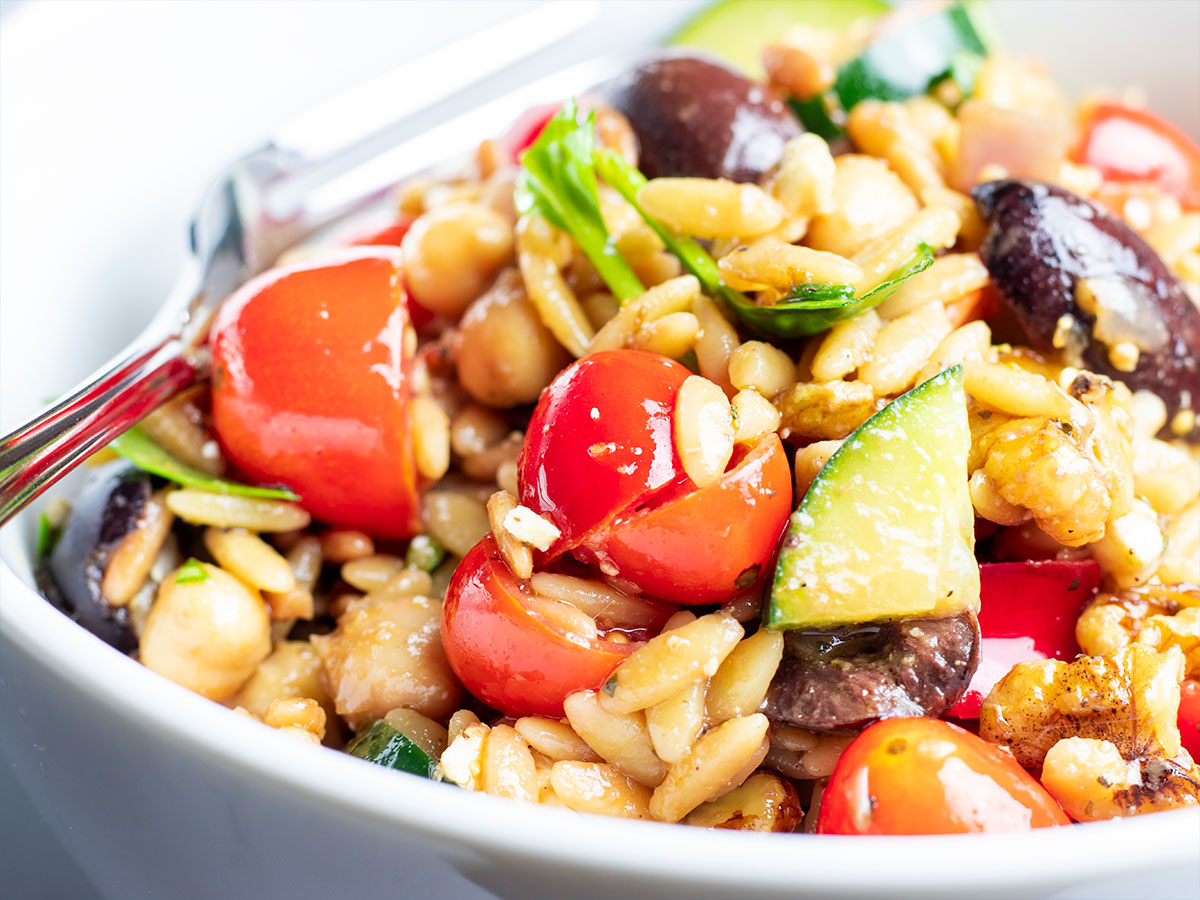
If you enjoyed this post, please consider sharing it on social media and signing up for my mailing list. That would help me out a lot. Also, if you have any questions or anything to add, please use the comment form down below. Thanks and enjoy!


Turned out amazing! Thank you for this great recipe.